Lenovo ThinkPad X1 Carbon Review
Lenovo ThinkPad X1 Carbon
This ThinkPad takes the executive Ultrabook to new heights.
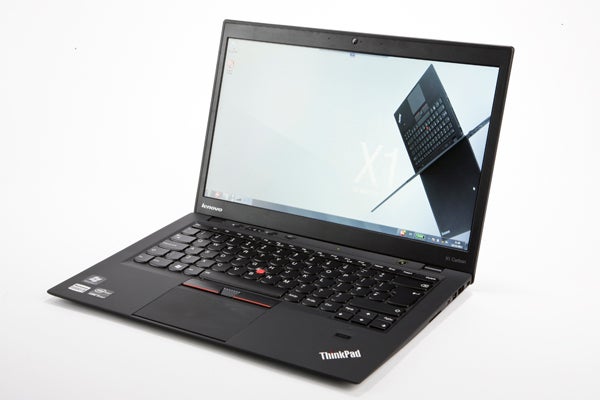
Verdict
Pros
- Stylish, light and sleek
- Superb backlit, spill-proof keyboard
- Durable soft-touch finish
- Powerful specs
- Good high-res screen
Cons
- No Ethernet port
- Screen panel still TN
Key Specifications
- Review Price: £1252.00
- 14in 1600 x 900 matt TN screen
- Part carbon-fibre chassis with soft-touch finish
- Spill-proof, backlit keyboard
- Up to Core i7, 8GB RAM, 240GB SSD
- TPM, Optional 3G, Fingerprint scanner
Introduction
You may remember the original Lenovo ThinkPad X1. It was Lenovo’s first attempt at bringing a super-slim, streamlined aesthetic to its famous ThinkPad line, and it wasn’t quite a success. Despite being sleek and offering high-end features, the laptop wasn’t actually all that slim or light, its battery life was poor, its glass screen reflective, and its connectivity slightly awkward. With the X1 Carbon, Lenovo is looking to fix all that, and finally provide lovers of MacBook Air-like Ultrabooks a worthy ThinkPad entrant.
If you’re unfamiliar with the ThinkPad line, they’re basically some of the nicest-feeling and most rugged devices around. Thanks in large part to their IBM heritage, ThinkPad laptops offer the best mobile typing experience around and are stuffed with powerful features and extensive connectivity. Their soft-touch yet hard-wearing finish generally makes them a pleasure to handle and carry around, while their edgy black looks give them a great ‘Executive’ vibe.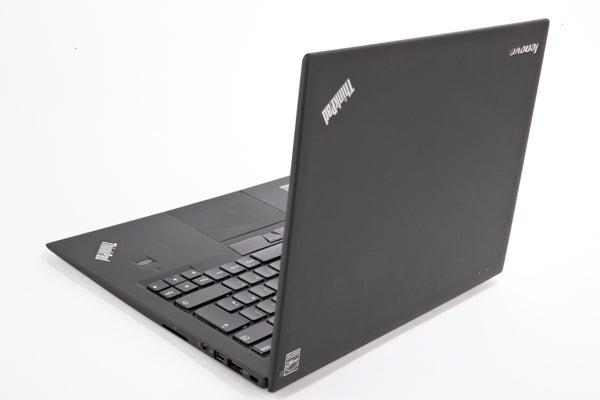
Unlike its 13-inch X1 predecessor, the X1 Carbon is a 14inch laptop, yet it manages to be considerably slimmer and lighter, at 1.4kg. That’s no mean achievement, especially given its powerful innards of up to a Core i7 processor with 8GB of RAM, but it’s mainly thanks to a carbon-fibre chassis (hence the name) and the lack of glass. The all-new, large touchpad is a welcome improvement, but the ergonomics and extras we know and love from the ThinkPad line are all present too, including a fantastic backlit keyboard, fingerprint scanner, TPM, optional 3G, V-Pro, matt high-resolution display, TrackPoint and more.
Lenovo ThinkPad X1 Carbon – Design and Build
Frankly, the Carbon makes its X1 predecessor look fat. It’s only 19mm thin at its thickest point, which compares favourably with the original X1’s 21mm and the likewise 14-inch HP Envy 14 Spectre Ultrabook, which is 20mm across without tapering. The Carbon tapers quite aggressively, however, and to very nice effect.
As with every other ThinkPad, the X1 Carbon comes in black with subtle red highlights. However – just like with the X1 – the somewhat discordant blue that was also used on older models has been left by the wayside to give this Ultrabook a more coherent design. Prominent branding aside, this Ultrabook is almost on a level with the likes of the Samsung Series 9 900X3B when it comes to looks. 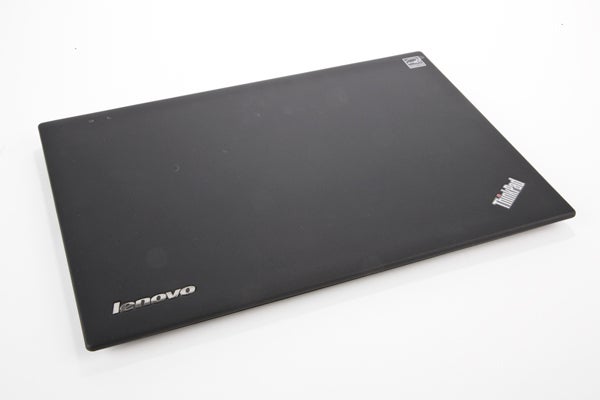
But the Carbon doesn’t just look great, it feels great too. Except for its screen bezel, the laptop’s entirety is coated in a soft-touch finish that makes it a pleasure to touch and carry while providing a secure grip. As proven by many previous ThinkPads with this same finish, it’s also very durable, and doesn’t pick up scratches or marks easily.
Build quality is another area where ThinkPads have a well-deserved excellent reputation. Obviously a carbon-fibre chassis is never going to feel as solid as a unibody aluminium one, but that doesn’t necessarily make it less rugged. In fact, Lenovo claims its composite chassis is just as tough, and you only need to check out the Panasonic Toughbook CF-19 if you’re not convinced that plastic can be far more durable than metal.
Lenovo ThinkPad X1 Carbon Connectivity
Inevitably connectivity has been a little compromised due to the slimness of this ThinkPad Ultrabook, with the most notable casualty being a Gigabit Ethernet jack. Though this can of course be added using a USB adapter (and Lenovo will include one for £12), we would have liked to see one in the box.
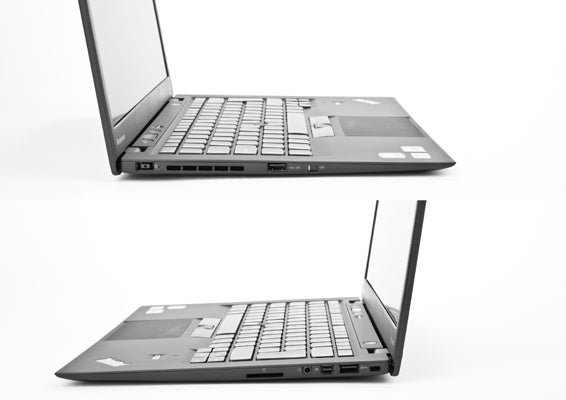
On the left we start off with a completely redesigned, slim power port that looks a lot like a USB port. This is followed by an play-and-charge USB 2.0 port, and wireless switch. On the right there’s a full-size SDXC card slot, headphone/microphone jack, mini DisplayPort with audio and USB 3.0 port. Wireless options include Wi-Fi N, Bluetooth 4.0 and 3g/wireless broadband, the latter of which is still a rarity on laptops.
For video chatting there’s a 720p webcam with decent quality footage and dual array microphones for clear audio all housed in the screen’s bezel.
Lenovo ThinkPad X1 Carbon – Keyboard and Typing
Lenovo has a well-deserved reputation for providing the best keyboards to grace laptops bar none, and the ThinkPad X1 Carbon doesn’t break that tradition. Though the ThinkPad line has transitioned to isolation/Chiclet style keys, they’re large and slightly concave, which fits them to your fingers just right.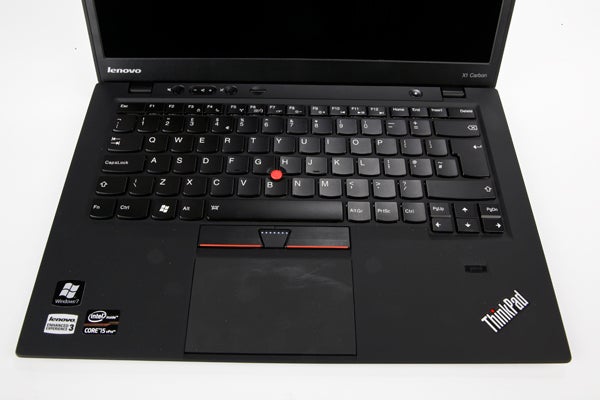
Layout is generally superb, though Lenovo is one of the few manufacturers clinging to having the function key to the outside of Ctrl, making classic shortcuts like Cut/Copy/Paste more fiddly. Key feedback is also excellent, with more travel than most slim Ultrabooks (heck, most laptops for that matter) manage and a nicely defined click. Basically, typing on this X1 is a genuine pleasure and if word processing is your bread and butter, there are no slim laptops we’d rather do it on.
As the Carbon is a premium ThinkPad, the keyboard is also fully backlit and here the backlighting is even adjustable. The keyboard is spill-resistant too, meaning you can upend your cuppa over it without any dire consequences.
Lenovo ThinkPad X1 Carbon – TrackPoint and Touchpad
Of course, no ThinkPad would be complete without its TrackPoint, a little red rubber pointing stick nestled between the G and H keys which you can use to move the mouse cursor without moving your hands from the typing position. After a short learning curve this can essentially replace the touchpad, though they’re best used together, with each offering strengths in different usage scenarios.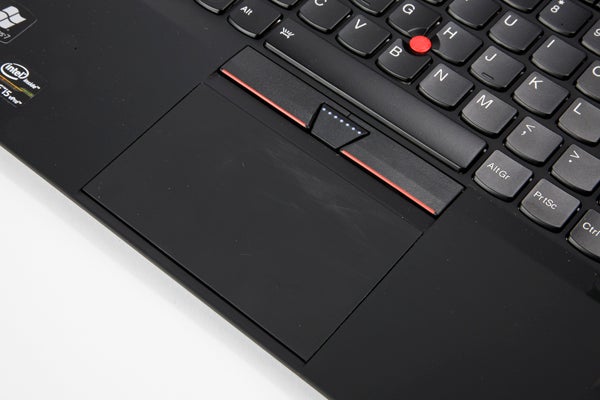
As with TrackPoints that went before, the one here has its own set of dedicated buttons located between the keyboard’s bottom edge and the touchpad’s upper one. They’re ergonomically shaped to accommodate your fingers while remaining clearly differentiated, and sport lovely crisp action too.
The touchpad is actually one of the biggest areas of change from many previous ThinkPads. For one thing, it’s absolutely massive. For another, its surface is now glass and its buttons are integrated, just like most other premium Ultrabooks.
As this was the one area where ThinkPads lagged noticeably behind the competition, we’re glad to report that this latest touchpad iteration works beautifully. The pad’s smooth surface is a pleasure to run your finger across, it’s nicely responsive, and its buttons offer a defined click though this is not as crisp as the action found on some rivals.
Lenovo ThinkPad X1 Carbon Screen
Considering Lenovo was one of the pioneers of high-quality IPS screens in laptops like its ThinkPad X220 long before other manufacturers were offering them on anything but high-end workstations, it’s disappointing to find that the X1 still uses a TN-panel display. Mind you, as these go the ThinkPad X1 Carbon is top of its class, if not quite as good as last year’s Samsung Series 9 900X3A. 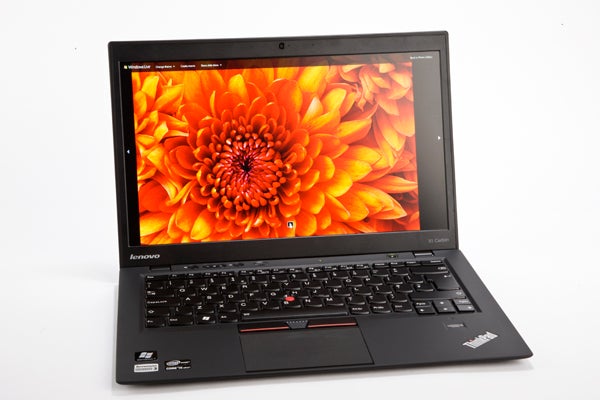
First off, it’s worth pointing out that the 14-inch X1 Carbon comes with two different display resolutions, depending on which model you go for. The cheaper Carbons offer a standard 1,366 x 768 resolution, while the high-end variants – like our review sample – come with a much nicer 1,600 x 900 pixel count (you can upgrade from the regular resolution to Premium HD Plus for £62 when buying direct from Lenovo). Either way you get a great matt finish, avoiding the annoying reflections of glossy screens – though it does also make pixel structure a little more visible, but that’s a small price to pay.
Viewing angles are also very good by TN standards. Horizontally they’re almost flawless, with only a slight bit of contrast shift betraying that we’re not dealing with IPS here. Vertically there’s less leeway, but you can still tilt the display with a little more freedom than most. And as with every premium ThinkPad, you can fold the screen back to 180 degrees.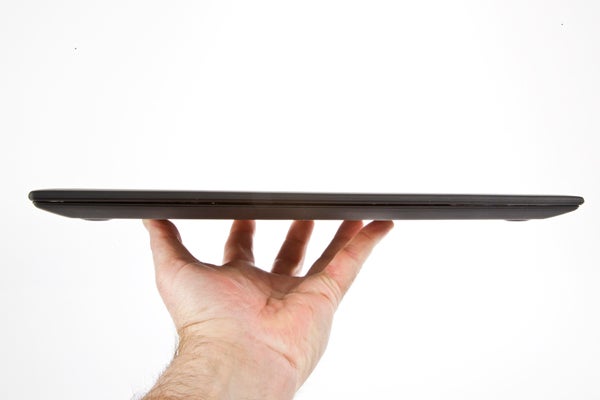
Combined with good maximum brightness, excellent dark detailing, decent contrast, punchy colours, and no signs of backlight bleed or other undesirable artefacts, the Lenovo ThinkPad X1 Carbon offers a pleasant visual experience – not just for work but entertainment too.
Lenovo ThinkPad X1 Carbon – Speakers
Audio is remarkably good for a business ultra-slim. The X1 Carbon’s speakers go pretty loud without too much distortion and manage a reasonable mid-range, though bass is noticeable only by its absence. We probably wouldn’t watch an epic movie on this Ultrabook without headphones, but for lighter fare it’s adequate. Volume, mute and mic mute can be controlled using dedicated buttons above the keyboard.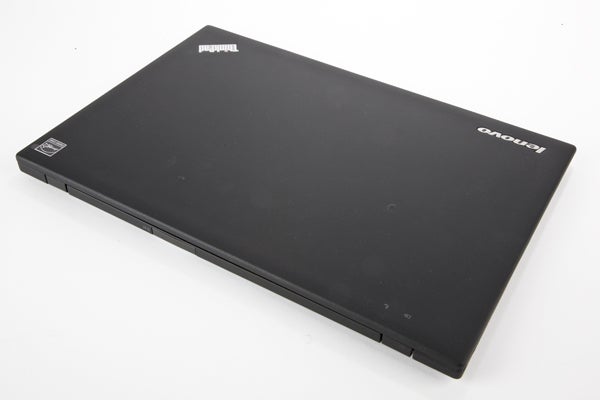
Lenovo ThinkPad X1 Carbon – Specs and Performance
High-end ThinkPads have rarely compromised on power, and the X1 Carbon certainly gives you enough to run even the most intensive (non-3D) software. The £1,190 config sports the common Core i5 backed by 4GB of RAM and a 128GB hard drive, while £1,700 will get you a Core i7, 8GB of RAM and a 240GB SSD. Make sure you have enough RAM for your needs as, unlike most ThinkPads (but like many Ultrabooks) you can’t upgrade the amount on the Carbon afterwards.
(u)PCMark 07(/u)
General: 4963
Entertainment: 3798
Our review sample ran a dual-core Intel ‘Ivy Bridge’ Core i5-3427U that hums along at 1.8GHz but can Turbo Clock up to 2.8GHz and offers Hyper-Threading for virtual quad-core support. It was backed by 8GB of DDR3 RAM and the 240GB SSD, which is a speedy Samsung model – an excellent choice for performance and reliability.
(u)Gaming(/u)
TrackMania Nations Forever (average fps, 720p, Medium Detail)
42.3
S.T.A.L.K.E.R: Call of Pripyat (average fps, 720p, Medium Detail)
26.4
This system happily ripped through most of our benchmarks, with only 3D gaming a relative weak spot thanks to Intel’s integrated HD 4000. With a 26.4fps average at medium settings in Stalker, which is hardly a demanding title by modern standards, only casual gamers need apply – but that goes for most Ultrabooks and the ThinkPad X1 Carbon is, after all, a business machine.
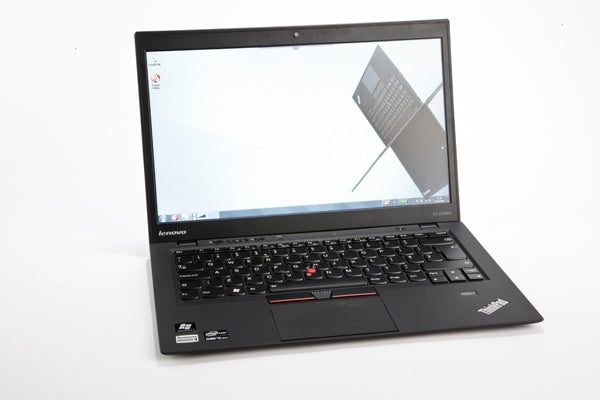
It’s worth noting that the Carbon stays quiet and only slightly warm even when under load, due to some excellent engineering on Lenovo’s part. These are major plus points as many slim Ultrabooks can be both noisy and rather hot when pushed.
Lenovo ThinkPad X1 Carbon – Windows 8 and Touch
The X1 Carbon comes with Windows 8 by default, but you can switch to Windows 7 Professional for a mere 95 pence. As the Carbon doesn’t come with a touchscreen yet, the older version of Microsoft’s operating system probably makes more sense right now. If you do want touch, to go with Windows 8’s ‘Metro’ style interface and apps like Angry Birds, Lenovo has revealed it will soon be offering a touch screen option on its premium business Ultrabook.
Where other software is concerned, the ThinkPad X1 Carbon comes with a host of Lenovo-specific ThinkVantage bits for wireless and battery management, security, maintenance and the like. Unlike similar apps from some rivals, these are not only slick and user-friendly, but genuinely enhance Windows’ core functionality.
Lenovo ThinkPad X1 Carbon – Battery Life
Battery life is the bane of many a slim Ultrabook, but again the X1 Carbon acquits itself well. It managed just over seven and a half hours in our standard mixed productivity test – a marked improvement over the original Lenovo ThinkPad X1’s three and a bit, and in line with the best of the rest.
(u)Battery(/u)
(40 percent screen brightness, wireless radios disabled, mixed productivity)
452 minutes
Mind you, if you use wireless radios (especially 3G) this figure is likely to go down steeply and, unlike for its predecessor, there’s no optional slice battery. Still, with careful use it should last you through a working day, and thanks to Lenovo’s RadipCharge tech, plugging it in for just half an hour will get you up to five hours’ use. 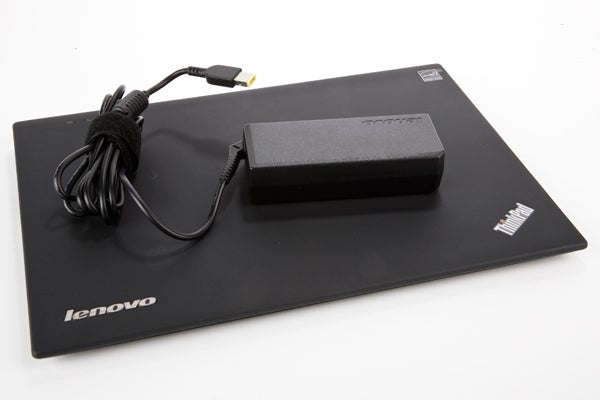
Lenovo ThinkPad X1 Carbon – Price
When it comes to value, this ThinkPad holds up pretty well. Sure you pay a premium over the average consumer Ultrabook, but you’re getting superb build quality, unmatched ergonomics, a pretty decent screen, good battery life and a host of essential business features like TPM and V-Pro, along with a class-leading three year warranty.
If buying direct from Lenovo, we would definitely recommend upgrading the screen resolution even if you opt for the ‘base’ model, meaning you’re looking at £1,252. Adding 3G takes this up to £1,320.
Compared to the other big-name 14-inch premium Ultrabook on the market, the £980 HP Envy Spectre 14, you’re getting similar specs, the same screen resolution and at least as much style from the HP. However, it’s a consumer-oriented machine and lacks the ruggedness and hardware/software security features of the ThinkPad X1 Carbon, not to mention 3G. It’s also far thicker and heavier, a real fingerprint magnet, and not as nice to use, plus you can’t upgrade it to the same impressive specs.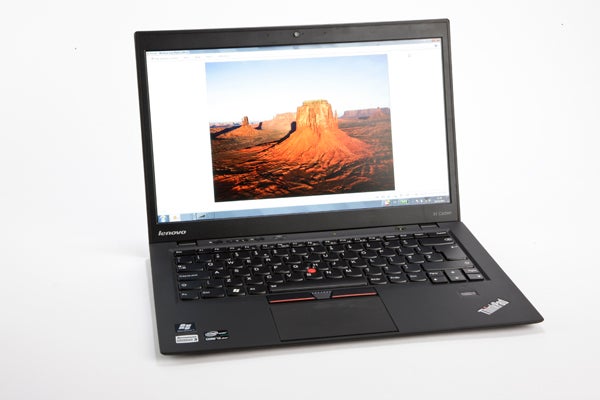
Another inevitable comparison will be the MacBook Air 13-inch. Again though, the Air is simply not a business machine and, aside from the benefits mentioned above, the Carbon gives you more screen real estate, a superior typing experience, and a more pleasant finish without the sharp edges. If you are after something more consumer-oriented, the Samsung Series 9 is definitely worth checking out.
Verdict
The Lenovo ThinkPad X1 Carbon is everything the original X1 should have been. Though its TN screen doesn’t quite match up to the premium style, build and features of this stunning Ultrabook, in every other regard it’s easily the best business ultraportable around. Its soft-touch chassis is a pleasure to carry or rest your hands on, and despite being stuffed with features, it retains an incredibly slim and sleek profile for a 14-inch machine. The Carbon’s keyboard quite simply offers the best typing experience of any Ultrabook. And though it packs some serious specs, it’s remarkably quiet even under load.
How we test laptops
Unlike other sites, we test every laptop we review thoroughly over an extended period of time. We use industry standard tests to compare features properly. We’ll always tell you what we find. We never, ever, accept money to review a product.
Trusted Score
Score in detail
-
Performance 9
-
Design 9
-
Screen Quality 8
-
Value 8
-
Features 8
-
Battery Life 8

